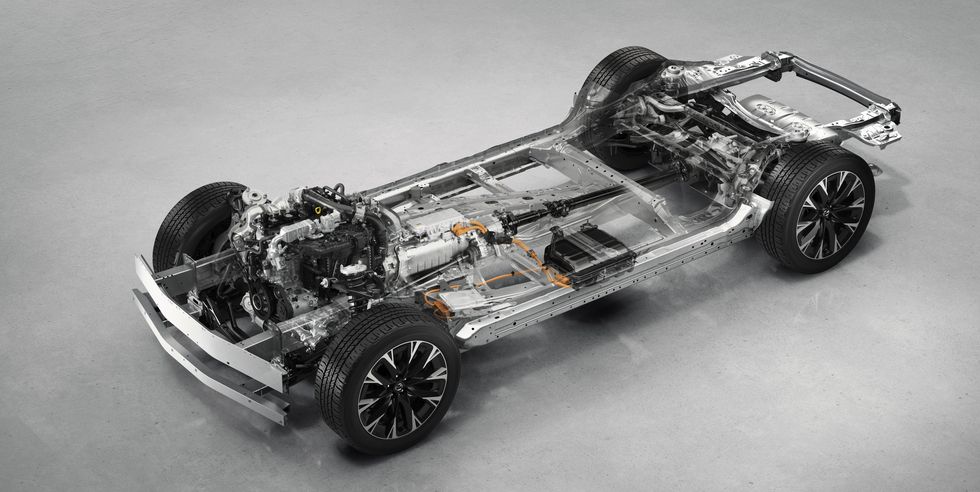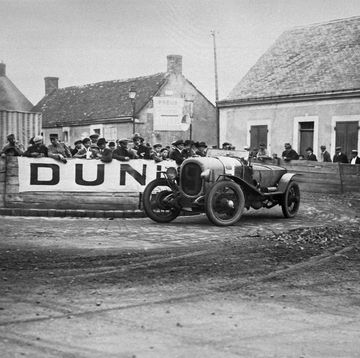As we face the end of the internal-combustion era, the straight-six has made an unlikely comeback. Well, unlikely might not be the right word for an engine configuration of such fundamental rightness. What’s unlikely is that Mazda, better associated with rotaries and four-cylinder engines, has just launched its first straight-six ever. For the U.S. market, this new six debuts in the CX-90 SUV.
So what's so great about a straight-six? It's really down to the engine layout’s simplicity, packaging, and smoothness. In contrast to a V-6, a straight-six requires just one cylinder head and only one or two camshafts; a straight-six is narrow, leaving more room under hood for turbochargers, suspension components, and crash structure; the change of direction as pistons reach top and bottom dead center is mirrored by pistons on the other side of the engine, canceling out first order vibrations. Then of course, there's the power, torque, and not inconsequentially, the intoxicating noise of a good straight-six.
For that reason, straight-sixes were common in cars for decades, though they fell out of favor in the Eighties and Nineties for V-6s that shared architecture with V-8s. But now that the most popular automotive engine is the inline-four and V-8s are going away, the straight-six once again makes sense, at least in longitudinal applications. Mercedes-Benz, Jaguar Land Rover, and Stellantis have all got in on the game in the last decade.
Mazda is, rather unusually, getting into the straight-six business for the first time. The brand is pushing upmarket, staking its bold play on a new rear-drive architecture for a lineup of SUVs (and possibly sedans). For most of the last decade-and-a-half, Mazda built only four-cylinders in various displacements. At least in this application, the straight-six is not simply a lengthened version of Mazda's four-cylinder, as the bore and stroke dimensions aren't the same. Still, one imagines there's a lot of commonality between the two engines, because, well, why wouldn't there be?
Jay Chen, powertrain head at Mazda North America Operations, explains the straight-six was the right mill to propel the company’s luxury aspirations. The new rear-drive architecture provided the CX-90 enough length to use a straight-six, and the engine's narrow dimensions also allowed for double-wishbone suspension, the ideal layout for great ride and handling. Chen says the straight-six also allowed more room for crash structure.
Perhaps most notable is the engine’s 12:1 compression ratio, unusually high for a production turbocharged mill. That compression ratio is higher than the 10.5:1 of Mazda's 2.5-liter turbo four and even the 11:1 of BMW's B58 straight-six. Nissan's neat variable-compression turbo engine can run as high as 14:1, but as low as 8:1. Generally speaking, higher compression boosts power and efficiency, though obviously, those increases subject the engine’s components to greater stress overall.
As such, turbocharged engines typically run a lower compression ratio, aiming for a sweet spot between power, efficiency, and longevity. But, Mazda has long used high-compression engines to provide great performance and real-world fuel economy, so it was only natural that it'd leverage expertise in that area with this six-cylinder.
For the CX-90, Mazda offers the 3.3-liter with two outputs. The first produces 280 hp and 332 lb-ft. Turbo S models make 340 hp and 369 lb-ft. From a hardware perspective, the engines are identical. The lower output engine is meant to run on standard 87-octane fuel. As such, the turbo only provides 14.0 psi of boost. (If you put higher-octane fuel in, it won't make a difference). The Turbo S engine requires 93 octane to deliver its full output, running 19.1 psi of boost. If you put 87 in a Turbo S, power output reduces to 319 hp while torque remains the same. Chen says he'd likely run the Turbo S on lower-octane fuel, as the real-world performance differences are insignificant.
Mazda says that despite bucking the trend toward engine downsizing, this relatively big six-cylinder provides better fuel economy at a given torque figure than its smaller-displacement cousins. Generally, a six-cylinder will provide more torque at lower revs than a four-cylinder, so the six isn't working too hard to heft the CX-90 around. Via its variable valve-timing system, this engine can also switch between the traditional Otto and Miller cycles, wherein the intake valve is held open slightly longer during the compression stroke to allow some fuel-air mixture back into the intake manifold. This increases the expansion ratio, the difference in cylinder volume between top dead center versus bottom dead center—essentially the opposite of compression ratio—providing a nice efficiency boost. (For more on this, Engineering Explained has a great video on the Atkinson cycle. The Miller cycle is essentially the same thing, but tweaked for forced induction.)
I recently experienced Mazda’s new straight-six in a loaded CX-90 Turbo S Premium Plus, and if there's any word to sum up the engine, it's “refined”. The engine’s so quiet and smooth, you sometimes forget it's running. In everyday driving, the straight-six provides a swell of useful torque. Above 5000 rpm, up to the engine’s 6000 rpm power peak, the mill doesn't have the verve of the BMW B58, but Mazda's six has a notably bigger bore. This engine shares much with a diesel straight-six Mazda offers in other global markets, and there's a diesel-esque character to it, doing its best work up to 4500 or so. The engine also pairs with a 48-volt "mild-hybrid" system, with a 16.6-hp, 113 lb-ft. electric motor integrated into the transmission bellhousing. This motor helps with transient response, but one imagines it's not doing too much at higher engine speeds. The mild-hybrid system allows the engine to turn off momentarily during coasting, firing up as soon as the driver touches the throttle. It's not unlike what Mercedes does with its new straight-six, which was the first of its type to adopt a mild-hybrid system.
Given it's a Mazda, I expected the 3.3-liter to feel sportier, like BMW's 3.0-liter. But this engine resides in a three-row luxury SUV, not a sports car. SUV buyers don't care about high-rpm performance—they just want a smooth and efficient punch of power. This engine delivers both. Its refinement vaults the CX-90 ahead of Japanese rivals like the Acura MDX, and the Lexus RX—now a four-cylinder only model—and leaves Mazda nipping at the heels of BMW’s X7 and Mercedes-Benz’s GLS.
This is not the engine’s final form, Chen says. Think of this straight-six as something of a platform unto itself. It was designed with flexibility in mind, so Mazda can tailor its specifications to future products, ones smaller than the CX-90. The CX-70 should soon follow the CX-90. Chen also suggests this engine will end up in a sedan of some sort (just don't call it a Mazda 6).
While entering luxury territory may be a bold step, the choice to do so with a straight-six isn't. This engine’s appeal is undeniable.
A car enthusiast since childhood, Chris Perkins is Road & Track's engineering nerd and Porsche apologist. He joined the staff in 2016 and no one has figured out a way to fire him since. He street-parks a Porsche Boxster in Brooklyn, New York, much to the horror of everyone who sees the car, not least the author himself. He also insists he's not a convertible person, despite owning three.















